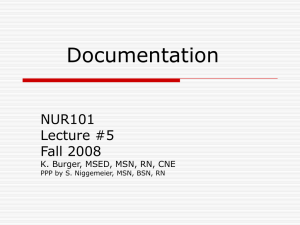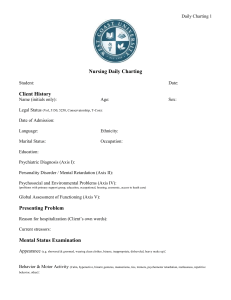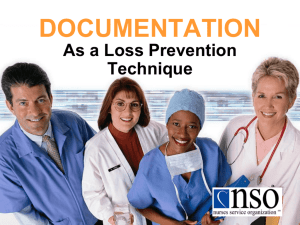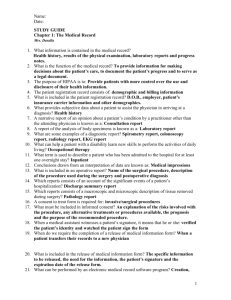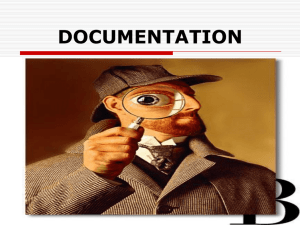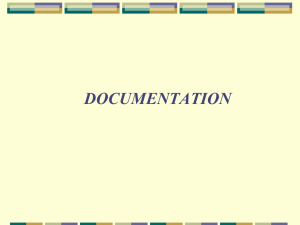records
advertisement
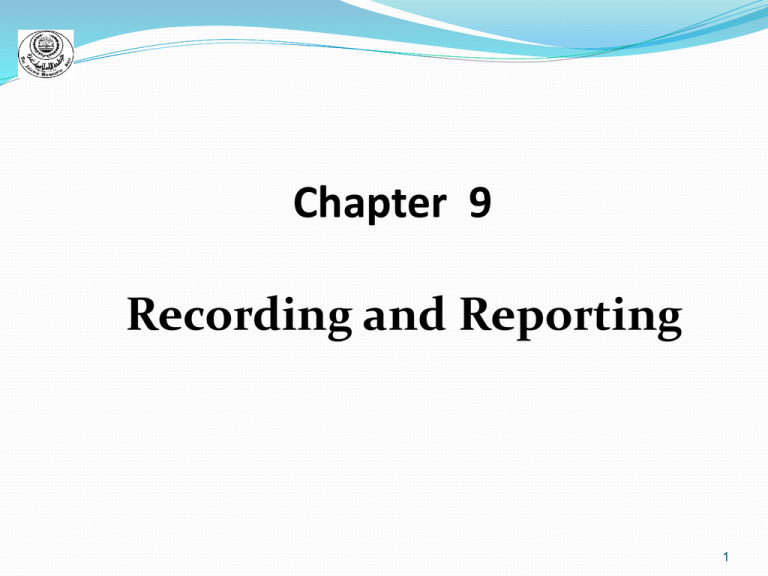
Chapter 9 Recording and Reporting 1 Medical Records Recording referred to (process of writing information) Other words (Reporting, Documenting, Charting, and Recording) . Medical (health) records are written collections of information about a person’s health, the care provided by health practitioners, and the client’s progress Also known as health records or client records (files) 2 Uses of Medical Records 1. Permanent account The record is filled and maintained for future references. 2. Sharing information Continuing of care. Prevent duplication or omission 3. Quality assurance Continues quality improvement. To improve the quality of care. Accreditation (Official Approval) 4. 5. Reimbursement (To pay the coasts of documented care). 6. Education and research 7. Legal evidence 3 Components of Medical Records 1. Person’s health information 2. Care provided by health practitioners 3. The client’s progress 4. The plan for care 5. Medication cycle 4 Types of patient's records 1. Source-Oriented Records Organized according to source of documented information Contain separate forms for physicians, nurses, dietitians, physical therapists to make written entries about their specific activities in relation to client’s care This record provides fragmented documentation Consider of traditional type of record 5 2. Problem-Oriented Records Organized according to client’s health problems Four major components: data base, problem list, plan of care, progress notes Information arranged to emphasize goal-directed care; promote recording of pertinent information; facilitate communication among health care professionals 6 Components of Problem-Oriented Records 7 Methods of Charting 1. Narrative charting Style of documentation generally used in Source-Oriented Records. Involve writing information about the patient and patient's care in a chronologic order. 2. SOAP charting Style of documentation more likely to be used in a Problem-Oriented Record. S = Subjective Data. O = Objective Data.. A = Analysis of the Data.. P = Plan for care. Some agencies have expanded the SOAP format to SOAPIE or SOAPIER I = Interventions E = Evaluation R = Revision to the plan of care 8 Methods of Charting (cont’d) 3. Focus charting (DAR model is used ) D = Data A = Action R = Response 4. PIE charting P=Problem I=Intervention E=Evaluation 5. Charting by exception Method in which only abnormal assessment finding are written. 6. Computerized method Documenting patient information electronically 9 DOCUMENTING INFORMATION Abbreviations Abbreviations shorten length of documentation and documentation time Agencies provide list of approved abbreviations and their meanings Use only abbreviations on agency’s approved list 10 DOCUMENTING INFORMATION (cont’d) Documentation Time 1. Traditional time – Two 12-hour revolutions; identified with hour and minute, followed by a.m. or p.m. 2. Military time – Based on 24-hour clock; uses different four-digit number for each hour and minute of the day o First two digits indicate hour within 24-hour period o Last two digits indicate minutes 11 Documentation Time (cont’d) 12 Charting Guidelines Should not be time-consuming to write and read Everyone involved in the care of a client should make entries in the same location in the chart The nurse should address specific content in charted progress notes Assessments should be documented on a separate form Information should always be clear 13 Charting Guidelines (cont’d) Abnormal assessment findings, or care that deviates from the standard, should also be documented separately Client information should be documented electronically Abbreviations and terms should be consistent with agency-approved lists The date of the documentation should be recorded The time of the documentation should be recorded 14 Written Forms of Communication 1) Nursing care plan: list of client’s problems, goals, and nursing orders for client care 2) Nursing Kardex: quick reference for current information about client and client care 3) Checklists: documentation with check mark or initials 4) Flow sheets: documentation with sections for recording frequently repeated assessment data 15 Other Forms of Communication 1. Change of shift reports: Discussion between a nursing spokes person from the shift that is ending and personnel coming duty. 2. Client assignments: Are made at the beginning of each shift. 3. Team conferences : Are commonly used for exchanging information 4. Rounds : Visit to patients on an individual basis or as group 5. Telephone calls 16 Nursing Documentation 17
